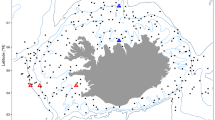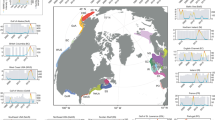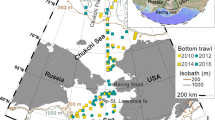Abstract
Studies documenting distributional shifts of fishes typically rely on time series of annual sampling events with fixed seasonal timing and limited temporal range. Meanwhile, as temperatures along the Northeast continental shelf have increased, the seasonal cycle also shifted towards earlier spring warming and longer summers. Seasonal migrations of fish and macroinvertebrates on the continental shelf in the Northeast US are thought to be primarily controlled by temperature and as such likely follow the temperature phenology of the shelf. This study sought to determine whether apparent changes in fish biomass and distributions are linked to spring warming phenology and/or duration of summer, the effective growing season for most species. We hypothesized that the earlier spring thermal transition would occur earlier and would cause centers of biomass to be more poleward during the spring survey. We also expected lengthening summers, primarily a function of later fall cooling, to cause centers of biomass in the fall survey to be more poleward and for biomass on the shelf to be greater within and following longer growing seasons. We did not detect a strong effect of the timing of the spring thermal transition in sea surface temperature on the distribution or abundance for most of the 43 fish stocks that we examined. However, later fall cooling and longer summers had a strong effect on both abundance and biomass of many fish stocks. These findings suggest that more focus should be placed on the length of the growing season and population-level processes that result in distributional shifts and changes in abundance.







Similar content being viewed by others
References
Amano T, Smithers RJ, Sparks TH, Sutherland WJ (2010) A 250-year index of first flowering dates and its response to temperature changes. Proc R Soc B Biol Sci 277:2451–2457. doi:10.1098/rspb.2010.0291
Azarovitz TR (1981) A brief historical review of the Woods Hole Laboratory trawl survey time series. Can Spec Publ Fish Aquat Sci 58:62–67
Baumann H, Doherty O (2013) Decadal changes in the world’s coastal latitudinal temperature gradients. PLoS ONE. doi:10.1371/journal.pone.0067596
Burrows MT, Schoeman DS, Buckley LB et al (2011) The pace of shifting climate in marine and terrestrial ecosystems. Science 334:652–655. doi:10.1126/science.1210288
Cargnelli LM, Griesbach SJ, Berrien PL et al (1999) Essential fish habitat source document: Haddock, Melanogrammus aeglefinus, life history and habitat characteristics. NOAA Tech Memo NMFS-NE:iii + 31 p
Deutsch C, Ferrel A, Seibel B et al (2015) Climate change tightens metabolic constraint on marine habitats. Science 348:1132–1136
Edwards M, Richardson AJ (2004) Impact of climate change on marine pelagic phenology and trophic mismatch. Nature 430:881–884. doi:10.1038/nature02808
Edwards M, Johns DG, Richardson AJ (2006) Regional climate change and harmful algal blooms in the northeast Atlantic. Limnol Oceanogr 51:820–829
Fogarty M, Incze L, Hayhoe K et al (2008) Potential climate change impacts on Atlantic cod (Gadus morhua) off the northeastern USA. Mitig Adapt Strateg Glob Change 13:453–466. doi:10.1007/s11027-007-9131-4
Friedland KD, Hare JA (2007) Long-term trends and regime shifts in sea surface temperature on the continental shelf of the northeast United States. Cont Shelf Res 27:2313–2328. doi:10.1016/j.csr.2007.06.001
Friedland KD, Leaf RT, Kane J et al (2015) Spring bloom dynamics and zooplankton biomass response on the US Northeast continental shelf. Cont Shelf Res 102:47–61. doi:10.1016/j.csr.2015.04.005
Ji R, Edwards M, MacKas DL et al (2010) Marine plankton phenology and life history in a changing climate: current research and future directions. J Plankton Res 32:1355–1368. doi:10.1093/plankt/fbq062
Juanes F, Gephard S, Beland KF (2004) Long-term changes in migration timing of adult Atlantic salmon (Salmo salar) at the southern edge of the species distribution. Can J Fish Aquat Sci 61:2392–2400. doi:10.1139/F04-207
Mills KM, Pershing AJ, Brown CJ et al (2013) Fisheries management in a changing climate: lessons from the 2012 ocean heat wave in the Northwest Atlantic Ocean. Oceanography 26:191–195
Mueter FJ, Litzow MA, Applications SE, Mar N (2013) Sea ice retreat alters the biogeography of the Bering Sea continental shelf. Ecol Appl 18:309–320
Murawski SA (1993) Climate change and marine fish distributions: forecasting from historical analogy. Trans Am Fish Soc 122:647–658
Myers RA, Drinkwater KF (1989) The influence of Gulf Stream warm core rings on recruitment of fish in the northwest Atlantic. J Mar Res 47:645–656
Neuheimer AB, Thresher RE, Lyle JM, Semmens JM (2011) Tolerance limit for fish growth exceeded by warming waters. Nat Clim Change 1:110–113
Nye J, Link J, Hare J, Overholtz W (2009) Changing spatial distribution of fish stocks in relation to climate and population size on the Northeast United States continental shelf. Mar Ecol Prog Ser 393:111–129. doi:10.3354/meps08220
Nye JA, Joyce TM, Kwon Y-O, Link JS (2011) Silver hake tracks changes in Northwest Atlantic circulation. Nat Commun 2:412. doi:10.1038/ncomms1420
Packer DB, Griesbach SJ, Berrien PL et al (1999) Essential fish habitat source document: summer flounder, Paralichthys dentatus, life history and habitat characteristics. Northeast Fisheries Science Center, Woods Hole, MA
Peer AC, Miller TJ (2014) Climate change, migration phenology, and fisheries management interact with unanticipated consequences. N Am J Fish Manag 34:94–110. doi:10.1080/02755947.2013.847877
Perry A, Low P, Ellis J, Reynolds J (2005) Climate change and distribution shifts in marine fishes. Science 308:1912–1915. doi:10.1126/science.1111322
Pershing AJ, Alexander MA, Hernandez CM et al (2015) Slow adaptation in the face of rapid warming leads to collapse of the Gulf of Maine cod fishery. Science 350:809–812. doi:10.1126/science.aac9819
Pershing AJ, Alexander MA, Hernandez CM et al (2016) Response to Comments on “Slow adaptation in the face of rapid warming leads to collapse of the Gulf of Maine cod fishery”. Science. doi:10.1126/science.aae0463
Pinsky ML, Worm B, Fogarty MJ et al (2013) Marine taxa track local climate velocities. Science 341:1239–1242. doi:10.1126/science.1239352
Portner HO, Farrell AP (2008) Physiology and climate change. Science 322:690–692
Reynolds RW, Smith TM, Liu C et al (2007) Daily high-resolution-blended analyses for sea surface temperature. J Clim 20:5473–5496. doi:10.1175/2007JCLI1824.1
Richards RA (2012) Phenological shifts in hatch timing of northern shrimp Pandalus borealis. Mar Ecol Prog Ser 456:149–158. doi:10.3354/meps09717
Rountree RA, Gilmore RG, Goudey CA et al (2006) Listening to fish: applications of passive acoustics to fisheries science. Fisheries 31:433–446
Xu H, Kim H-M, Nye JA, Hameed S (2015) Impacts of the North Atlantic Oscillation on sea surface temperature on the Northeast US continental shelf. Cont Shelf Res 105:60–66. doi:10.1016/j.csr.2015.06.005
Acknowledgements
The authors would like to thank the National Science Foundation for funding OCE-1325484, part of the Coastal SEES program. And Sean Lucey and Haikun Xu for answering questions about the data. We also thank the National Oceanic and Atmospheric Administration (NOAA) Northeast Fisheries Science Center (NEFSC) Ecosystems Surveys Branch for conducting the trawl survey.
Author information
Authors and Affiliations
Corresponding author
Electronic supplementary material
Below is the link to the electronic supplementary material.
11160_2017_9487_MOESM2_ESM.pdf
Supplemental Fig. S1 Annual mean center of biomass (coordinates) and survey-estimated biomass (size of points) in normal (gray) versus extremely early (red) and late (blue) spring warming years for all 43 fish and invertebrate stocks (PDF 260868 kb)
Rights and permissions
About this article
Cite this article
Henderson, M.E., Mills, K.E., Thomas, A.C. et al. Effects of spring onset and summer duration on fish species distribution and biomass along the Northeast United States continental shelf. Rev Fish Biol Fisheries 27, 411–424 (2017). https://doi.org/10.1007/s11160-017-9487-9
Received:
Accepted:
Published:
Issue Date:
DOI: https://doi.org/10.1007/s11160-017-9487-9




